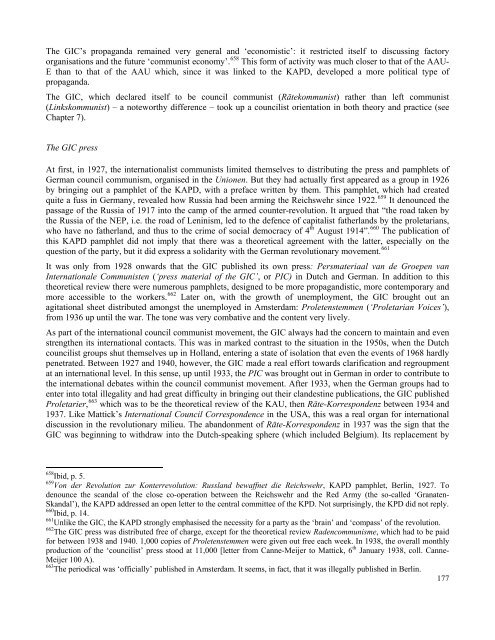The German-Dutch Communist Left - Libcom
The German-Dutch Communist Left - Libcom
The German-Dutch Communist Left - Libcom
You also want an ePaper? Increase the reach of your titles
YUMPU automatically turns print PDFs into web optimized ePapers that Google loves.
<strong>The</strong> GIC’s propaganda remained very general and ‘economistic’: it restricted itself to discussing factory<br />
organisations and the future ‘communist economy’. 658 This form of activity was much closer to that of the AAU-<br />
E than to that of the AAU which, since it was linked to the KAPD, developed a more political type of<br />
propaganda.<br />
<strong>The</strong> GIC, which declared itself to be council communist (Rätekommunist) rather than left communist<br />
(Linkskommunist) – a noteworthy difference – took up a councilist orientation in both theory and practice (see<br />
Chapter 7).<br />
<strong>The</strong> GIC press<br />
At first, in 1927, the internationalist communists limited themselves to distributing the press and pamphlets of<br />
<strong>German</strong> council communism, organised in the Unionen. But they had actually first appeared as a group in 1926<br />
by bringing out a pamphlet of the KAPD, with a preface written by them. This pamphlet, which had created<br />
quite a fuss in <strong>German</strong>y, revealed how Russia had been arming the Reichswehr since 1922. 659 It denounced the<br />
passage of the Russia of 1917 into the camp of the armed counter-revolution. It argued that “the road taken by<br />
the Russia of the NEP, i.e. the road of Leninism, led to the defence of capitalist fatherlands by the proletarians,<br />
who have no fatherland, and thus to the crime of social democracy of 4 th August 1914”. 660 <strong>The</strong> publication of<br />
this KAPD pamphlet did not imply that there was a theoretical agreement with the latter, especially on the<br />
question of the party, but it did express a solidarity with the <strong>German</strong> revolutionary movement. 661<br />
It was only from 1928 onwards that the GIC published its own press: Persmateriaal van de Groepen van<br />
Internationale <strong>Communist</strong>en (‘press material of the GIC’, or PIC) in <strong>Dutch</strong> and <strong>German</strong>. In addition to this<br />
theoretical review there were numerous pamphlets, designed to be more propagandistic, more contemporary and<br />
more accessible to the workers. 662 Later on, with the growth of unemployment, the GIC brought out an<br />
agitational sheet distributed amongst the unemployed in Amsterdam: Proletenstemmen (‘Proletarian Voices’),<br />
from 1936 up until the war. <strong>The</strong> tone was very combative and the content very lively.<br />
As part of the international council communist movement, the GIC always had the concern to maintain and even<br />
strengthen its international contacts. This was in marked contrast to the situation in the 1950s, when the <strong>Dutch</strong><br />
councilist groups shut themselves up in Holland, entering a state of isolation that even the events of 1968 hardly<br />
penetrated. Between 1927 and 1940, however, the GIC made a real effort towards clarification and regroupment<br />
at an international level. In this sense, up until 1933, the PIC was brought out in <strong>German</strong> in order to contribute to<br />
the international debates within the council communist movement. After 1933, when the <strong>German</strong> groups had to<br />
enter into total illegality and had great difficulty in bringing out their clandestine publications, the GIC published<br />
Proletarier, 663 which was to be the theoretical review of the KAU, then Räte-Korrespondenz between 1934 and<br />
1937. Like Mattick’s International Council Correspondence in the USA, this was a real organ for international<br />
discussion in the revolutionary milieu. <strong>The</strong> abandonment of Räte-Korrespondenz in 1937 was the sign that the<br />
GIC was beginning to withdraw into the <strong>Dutch</strong>-speaking sphere (which included Belgium). Its replacement by<br />
658 Ibid, p. 5.<br />
659 Von der Revolution zur Konterrevolution: Russland bewaffnet die Reichswehr, KAPD pamphlet, Berlin, 1927. To<br />
denounce the scandal of the close co-operation between the Reichswehr and the Red Army (the so-called ‘Granaten-<br />
Skandal’), the KAPD addressed an open letter to the central committee of the KPD. Not surprisingly, the KPD did not reply.<br />
660 Ibid, p. 14.<br />
661 Unlike the GIC, the KAPD strongly emphasised the necessity for a party as the ‘brain’ and ‘compass’ of the revolution.<br />
662 <strong>The</strong> GIC press was distributed free of charge, except for the theoretical review Radencommunisme, which had to be paid<br />
for between 1938 and 1940. 1,000 copies of Proletenstemmen were given out free each week. In 1938, the overall monthly<br />
production of the ‘councilist’ press stood at 11,000 [letter from Canne-Meijer to Mattick, 6 th January 1938, coll. Canne-<br />
Meijer 100 A).<br />
663 <strong>The</strong> periodical was ‘officially’ published in Amsterdam. It seems, in fact, that it was illegally published in Berlin.<br />
177
















